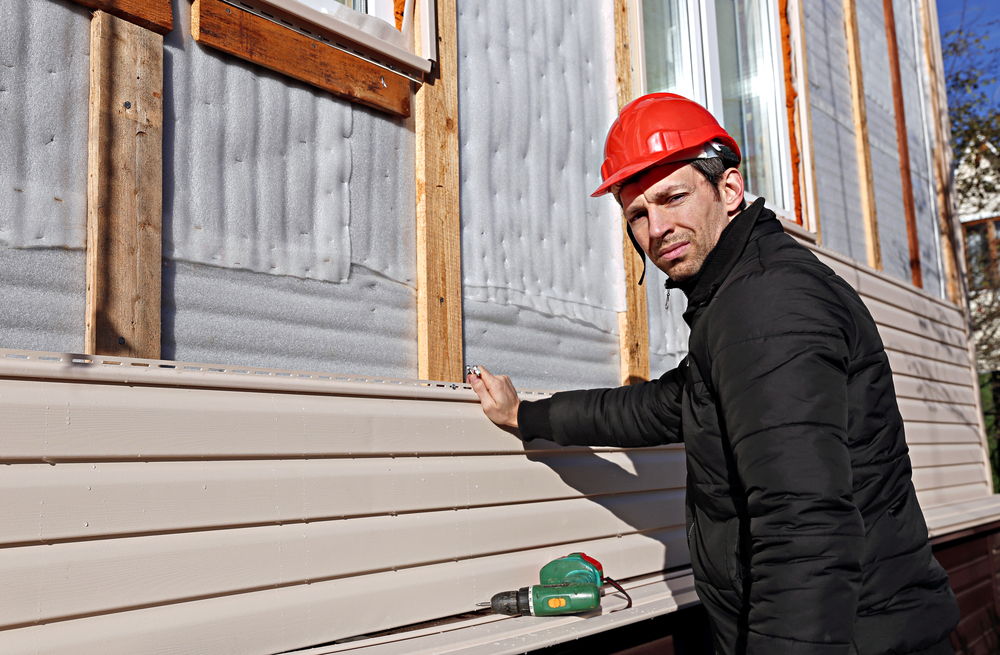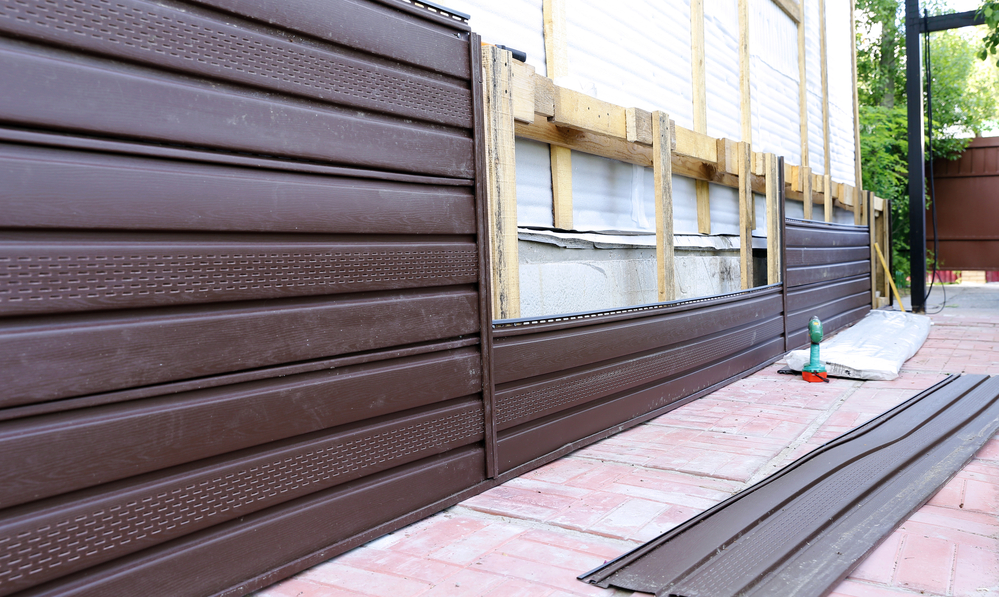Replacing all your vinyl siding can be costly.
Do you want to see your home looking better and more appealing, but that old, dingy vinyl siding is not giving you any positive vibes?
The easiest way to revamp your exterior and improve curb appeal would be to paint the siding.
Even though painting siding can be tiresome and time-consuming, it’s worth it, provided you clean it and paint when the weather is favorable.
Paint is also an excellent way to improve the exterior look of your home on a budget.
But before you invest time and money, you should ask, “how long will my vinyl siding last if I paint it?”
The Longevity of Painted Vinyl Siding
Let’s cut to the chase.
After getting a fresh coat, your vinyl siding will last approximately ten years.
However, the local climate plays a crucial role in the longevity of your vinyl siding.
Homes that get intense sunshine or storms are prone to damage, which might shorten your siding’s lifespan.
If you are living in Georgia, you can expect these climatic conditions.
As a southern state with low latitude, the state is often under the mercy of the hot sun.
The state is also vulnerable to storms and hurricanes from the Atlantic Ocean.
Despite those weather challenges, your siding will last for a considerable time – so long as a quality professional handles the job.
Choose the Paint
The first step to painting your vinyl siding would be to find the correct paint.
You would need a type of paint suitable for vinyl material which is recommended for exterior painting.
The paint should not crack whenever vinyl expands on a hot day or contracts.
The best paint would be latex urethane, labeled “vinyl safe,” which is suitable for exterior use.
You may use a primer if the manufacturer recommends so. Your color choice matters a lot too.
The vinyl material will warp, buckle, or melt if subjected to too much heat.
Dark colors can be beautiful, but only in Alaska. In Georgia, a dark color can absorb a lot of heat.
Guess what would happen to your vinyl siding if the temperatures rise?
Warping. Yikes! Choose a lighter color instead to enjoy the cooling quality.
Check Your Siding Condition
Before painting your vinyl siding, ensure it’s in excellent condition.
Go around your home inspecting the siding and check whether there are any broken or loose pieces or warping.
The good thing is that you won’t have to worry if a section of the siding is damaged.
If there are any, you’ll only have to buy new pieces of siding vinyl and replace the damaged ones.
You’ll want to avoid painting damaged vinyl siding.
It would look like a poorly done job by a kid playing with crayons.
Even worse, it would be an egg on your face sooner or later, and you’ll be required to do what you didn’t do the first time.
Running that roller over a damaged siding will also void the warranty.
Make sure your vinyl is in the proper condition before you paint it.
Give the Vinyl Siding a Good Wash
If you have painted before, you already know the rules.
Clean the surface before opening that bucket of paint.
A thorough cleaning helps achieve a quality paint job. Splashing water on your siding using your garden hose won’t simply cut it.
A solution of detergent and liquid bleach and scrubbing would help.
Use a trusted household cleaner and gallons of water until your siding looks as good as new.
Cleaning will eliminate the mold, mildew, and debris thrown against the wall by the wind.
If you ignore them, they’ll cause problems later.
After scrubbing one section, pressure wash it to get rid of every soapy solution.
Avoid getting water behind the vinyl siding to prevent damage later on.
Remember, safety is important.
You might need a ladder to reach higher spots.
Make sure you have someone to hold the base of the ladder.
Don’t climb with the cleaning tools to the top.
Only tie a rope to the top of the ladder.
You will use the rope to pull a bucket with the cleaning items to the top.
Prepare the Area
Paint tends to splatter onto surfaces where it’s not wanted.
You probably want to use a different paint color for your window frames, and you want your yard and lawns to maintain their natural look.
Put down a drop cloth on the area close to your siding.
Also, put some painter’s tape on your windows and door frames to prevent staining by the splatters.
Don’t Forget to Check the Weather!
Bad weather will ruin a new paint job. With it, wasted hours, paint, and you’ll have to buy new.
Before you get ready to paint, check the weather forecast for your city.
The most suitable conditions are low relative humidity, mild temperature, and dull clouds.
If it’s too hot or windy, the paint won’t adhere properly.
When the clouds open up, the rain shower will wash the paint right off.
The project might take you a day or more to complete.
Therefore, when checking the weather, find out how it will turn out that week.
The paint should rest for at least 24 hours before it can be rained on.
Why not paint when the sun is hot? You probably think this will help dry the paint faster, but that’s not the case.
Too much heat cures the paint poorly, and the paint will end up cracking and flaking after some time.
Prepare the Paint and Apply Primer if Necessary
Before applying the first coat, you might need to use the primer.
The primer will help improve the consistency of the paint and provide good adhesion.
Make sure to check the instructions on the bucket of paint.
Some don’t require a primer, but it’s recommended that you use it.
However, you might not need a primer if the original color has not worn away.
If you want to use a primer, apply it on the surface of your vinyl siding using a roller or sprayer.
These will help spread the primer much faster.
Only use the brush to cover the small areas a spray or roller might not reach.
You can also use the brush for back-brushing to remove the drips that the roller or spray might have left behind.
Apply Two Coats of Paint
Time is of the essence, and every passing day brings you closer to weather changes.
If the primer has dried, it’s time to apply paint on the vinyl siding.
Start with the first coat using the same technique as the primer.
Allow the coat to dry completely.
Depending on the brand of paint you used, it might take at least four hours to dry.
Some take eight hours. Others longer, depending on the weather.
After the first coat dries up, continue to the second coat.
Ensure not to apply too much paint in one section.
It’s advisable to do multiple light coats instead of one thick coat.
The second coat will take 24 hours to dry completely.
Once it dries and you realize the finishing is not that superb, you are welcome to lay another coat on it.
It might help bring incredible results.
Go Over Tricky Areas with Your Brush
Once you have done painting, inspect the siding.
If you notice that some tiny spaces didn’t get any paint, roll over them.
Some sections require back brushing in case excess paint goes into unwanted areas.
You can resolve them all with a brush.
Also, ask another person, perhaps your spouse, where they can catch any spots on the vinyl siding.
If they find any, you can use a brush to paint over those spots and bring a uniform look.
If you need help, that’s where we come in.
We can do the vinyl siding painting professionally in the shortest time.

Vinyl Siding: Painting vs. Replacing
There are several considerations when deciding whether to paint or replace your siding.
Even if it appears excellent on top, there could be some underlying issues that might make you choose to replace it instead.
At times, removing the whole siding might be the only option you have.
Before deciding whether to paint or replace your entire vinyl siding, let’s discuss the factors you want to consider.
The Cost of Replacement
Replacing and painting vinyl siding is not cheap, although painting is a cheaper option than replacing it.
Painting is faster, easier, and more affordable for most homeowners.
Replacing, on the other hand, is time-consuming and takes more money.
You should consider your budget as well as your needs.
Painting might be the best option for you if you are on a tight budget.
Age and Overall Condition
Hold old is your home?
If it’s relatively new, it’s better to paint than replace it.
A fresh coat of paint will make the siding appear more beautiful and last for about ten years.
However, if it’s older, you might have to replace a section or all of them.
Some signs of aged and damaged siding are cracks, holes, rot, mildew, and deterioration.
You should not ignore these signs as they may leave your home vulnerable, especially during a storm.
Even though the paint will change the look of your vinyl siding, the problems underneath will be left untouched.
The damaged ones should come off.
Warranty
Most vinyl siding panels are covered under warranty.
Your current vinyl siding probably has a warranty that hasn’t expired.
The warranty protects you from dents, damage, and improper installation.
The warranty might change because you painted your siding.
Make sure you understand the warranty.
Depending on the company you hire to paint your vinyl siding, you may get a warranty on the service.
If the paint cracks or gets damaged, the company will repaint the siding for free.
Newer siding may void an existing warranty if painted.
Pros of Painting Your Vinyl Siding
When you grab that roller or paint spray, remember that a lot of good would come from using them.
Here are the advantages of painting your vinyl siding.
Saves Money
Painting your vinyl siding saves you money.
The cost is even cheaper if you do it yourself instead of hiring a professional.
However, it would be best if you considered hiring a professional as they are quick and do their job well.
Still, if you hire a pro, painting is more affordable than replacing the vinyl sidings by far.
You Get More Color Options
They are many vinyl siding color options, and you would run out of options pretty quickly.
I wouldn’t say the same for paint colors.
The options stretch to the moon.
You can even mix custom paints to match the exact color you want.
There are also multiple manufacturers on the market, which means multiple choices.
Increases Your Home’s Value
Adding a simple coat of paint to your home’s exterior increases your home’s value.
Increased property value means your home will fetch a better price if you put it up for sale after you paint your vinyl siding.
Home buyers dislike dingy, faded, or peeling paint.
It also means they’ll be spending more money to repaint the home if they buy it.
Increases Curb Appeal
A fresh coat of paint will hide all the imperfections on your vinyl siding.
Those scratches, dirt, stains, and mold will disappear when you paint your siding.
Besides, apart from giving your home a fresh look, your home’s appearance will be changed for the better.
Your beautifully painted home will be the most vibrant on the street.

Increases Durability and Value of Your Home
If you use the right paint and follow all the steps, it will increase the durability of your vinyl siding.
On top of that, it will provide additional protection from elements that could shorten the overall life of the vinyl siding.
It also boosts the value of your home.
Buyers don’t want to see peeling, faded paint.
They want to get the impression that it’s a buy-and-move-in home.
Conclusion
A coat of paint over your vinyl siding will help maintain the longevity of the siding.
It will also help your home stand out. If you lack time to do it or want someone who can paint your vinyl siding professionally, contact Bravo Painting Company.
We are experts in this thing and always strive to meet your expectations.
Contact us, and we’ll send you a quote.
FAQs
Is painting vinyl siding a cost-effective way to improve my home’s appearance?
Yes, painting vinyl siding is a cost-effective way to enhance your home’s curb appeal compared to replacing it entirely.
How long does painted vinyl siding typically last?
Painted vinyl siding can last approximately ten years, but the durability can vary based on climate conditions and the quality of the paint job.
What type of paint should I use for vinyl siding?
It’s recommended to use latex urethane paint labeled as “vinyl safe” for exterior use when painting vinyl siding.
Do I need to use a primer before painting vinyl siding?
Some paints may require a primer, so check the paint manufacturer’s instructions. Using a primer can improve paint adhesion and consistency.



